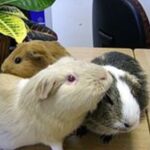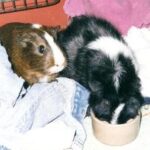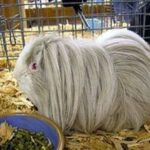There are four main types of cavies or guinea pigs – guinea pigs used for food, guinea pigs used in research, guinea pigs used in showing and guinea pigs kept as pets. Although within each of these types are a myriad of variations in colors, size and hair length, these are the main categories in life that a guinea pig winds up in.
Food Guinea Pigs
The Incas are thought to be the first peoples to domesticate the guinea pig. They did such a good job that we no longer can find a direct wild ancestor to the domestic guinea pig. Domestic guinea pigs have vastly different digestive tracts than the remaining species of wild guinea pigs. Just how the Incas bred the domestic guinea pig is unknown.
But why Incas bred domesticated them is known. Guinea pigs were one of the few sources of meat in the area. They breed relatively quickly (compared to a cow) and live off of kitchen scraps. Guinea pigs were even bred for specific meat flavors. They were also considered sacrificial animals to the gods. 1,000 white guinea pigs were killed every July alone.
Today, in the poorest sections of the Andes, guinea pigs are still bred for human consumption. Food cavies are bred to be larger than other types of cavies. In Peru, guinea pigs destined for the dining room table weigh up to seven pounds. Peru is hoping that guinea pig meat will become in demand in other countries.
Laboratory Guinea Pigs
Guinea pigs are so familiar to the general public as a lab animal that the term “guinea pig” is used by anyone undergoing a test for the first time. Guinea pigs lack the ability to make Vitamin C in their bodies – just like people. Work on guinea pigs lead to the discovery of Vitamin C in 1907, treatments for diphtheria and tuberculosis.
Many strains of guinea pigs were bred to develop a certain ailment to be worked on. These strains were known by numbers and not names. Today, only the strains 2 and 13 remain to sacrifice themselves to the gods of science. Occasionally these strains reached the pet market, including a mostly hairless strain known as the Baldwin. It was bred to be bald to make working on skin conditions easier.
Show Cavies
Showing and breeding guinea pigs for the show ring is a decreasingly popular hobby in hard economic times. The “cavy fancy” started in England and migrated to many other countries. Breeds were developed that had very specific hair coloration, eye colorations, nose shape, coat color, coat pattern, coat length or coat shininess. Show cavies have to wear an ear tag that is permanently attached through the ear.
Guinea pigs shows are similar to dog shows in that each guinea pig is measured against an impossible to attain ideal breed standard. Many of these guinea pigs find their way into the pet market when their showing and breeding careers are over, but sometimes they are sold to medical laboratories, given to owners of large pythons or killed. It all depends on the individual breeder’s ethics.
Pet Guinea Pigs
There are guinea pig mills in the same way that there are puppy mills and kitten mills. They supply pet stores, reptile food markets and sometimes laboratories with guinea pigs. People also “backyard breed” their guinea pigs for whatever crazy reason they come up with, even though spaying and neutering guinea pigs has become routine surgeries in the Western world. Despite the popular misconception, breeding guinea pigs is not profitable.
These are the mongrels of the guinea pig world and they are often filled with hybrid vigor and unique colorations and, coat lengths and coat textures. These are the types that people know and love the best. Hopefully, one day, they will be the only type of guinea pig in the world.
References:
“What’s My Guinea Pig?” Peter Gurney. TFH Kingdom Books; 1997.
“Guinea Pigs.” Audrey Pavia, et al. Bow Tie Press; 2005.
“Guinea Pigs: A Complete Pet Owner’s Manual.” Katrin Behrend. Barron’s Educational Series; 1998.
Christian Science Monitor. “Guinea Pigs: It’s What’s for Dinner in Peru and in the US.” Chip Mitchell. Nov.1, 2006. http://www.csmonitor.com/2006/1101/p04s01-woam.html
Florida Atlantic University Veterinary Services. “Laboratory Guinea Pig.” http://www.fau.edu/research/ovs/VetData/guineapig.php





